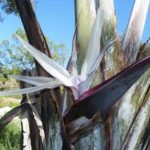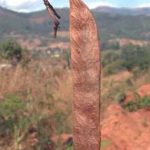TREE LIFE
August 2009
MASHONALAND CALENDAR
Sunday, August 16th: Ngomakurira in the Chinhamora Communal Area. A return visit to Ngomakurira. In many ways it is a grander version of Domboshawa with similar interesting and unusual vegetation parking is available at the base of the mountain, and there will be a fee. The amount is not known – so come prepared!
We will meet at 9.30 a.m. Please bring lunch and a chair.
Visit to Mfuti, Arcturus: 21 June 2009
On the morning of Midwinter’s Day, 2009, 12 of us gathered at the home of Mr. and Mrs. Vorster not far from Arcturus. Their home is on a hillside with views, as one can expect here, over other hills and into the distance. The name of the property is ‘Mfuti’ and we saw many of these trees around the house and in a forest along side and behind the farmstead. A fence separates it from the property beyond where we saw a grove of Mahobohobo, from which a few had infiltrated downwards into the Vorster property, lost among the Mfutis. Fresh tea was waiting for us in the summer house, for early birds! Many thanks to Mrs. Vorster for her kindness.
Mark led us down the driveway, and very slow was our progress. The first curiosity was a divided and smooth tree trunk, the thick base narrowing into the trunks, with spiky dry thin branches at right angles to the trunks and a single dry palmate leaf hanging onto the topmost twig. Mark concluded that this was, indeed, a baobab.
Mark had brought along a guest, a French botanist, Francis Lagarde, who may have been not a little surprised to find so many knowledgeable amateurs.
After asking JP a few simple questions I admitted that it would be wise for me to close my mouth for fear of advertising my ignorance in the presence of such company. JP generously claimed that he knew no tree names at the age of 65 years so I should ask away. Well, JP, it hasn’t taken you long to join the most knowledgeable! From him I learnt that the poinsettias, yellow and red and the ‘snow on the mountains’ which were blooming down the drive way were all of the same Euphorbia family with milky white latex, the flowers of the snow-on-the-mountains being tiny editions of the brightly coloured poinsettias (Euphorbia pulcherrima) from Mexico. These shrubs are exotics, but a tree is a tree and nature’s ways are always amazing.
According to Keith Coates Palgrave’s Trees of Southern Africa, the Euphorbia family – Euphorbiaceae – is a large and somewhat loose one [it takes up 64 pages in the book, and there are 36 tree genera and 1600 species] sharing certain characteristics, of which milky latex is the first mentioned. The Euphorbia genus of the Euphorbia family, has small modified leaves (bracts) associated with the flowers; these are fleshy, highly coloured and resemble thick lip-like petals. Another word, cyathium, is peculiar to the Euphorbia genus. Odd that poinsettias should have ‘thick lip-like’ petals like the easily recognized Candelabra trees of this genus. Naturally, the book passes by exotic poinsettias!
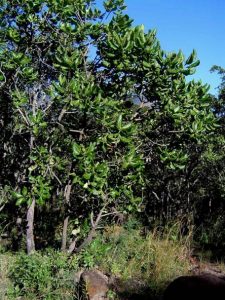
Uapaca kirkiana. Photo: Bart Wursten. Source: Flora of Zimbabwe
As a matter of interest, the Mahobohobo (Uapaca kirkiana) mentioned above is also of this family, as are the Crotons, the Duiker berry and the exotic Jatropha (Jatropha curcas L.) of which we have heard much of late. This plant, ‘the physic nut’ was introduced from tropical America many years ago and is thought to have spread from Mozambique through this country to the Republic of South Africa. It was used as living fences and the fruit provided an oil used for cosmetics, candles and soap. It has been used as a fish and arrow poison. The latex saps are usually harmful to the eyes and can be deadly poisonous.
At the bottom of the drive, we turned up the fence towards the hilltop – far in the distance it seemed. Drift is the way to describe this walk as we found one after another different and interesting species. French Francis was also drawing Mark’s attention to the smaller plants, some of which some of us know as ‘weeds’ in the lands or garden! Let us humble ourselves and acknowledge that they are also plants with characteristics worth noting.
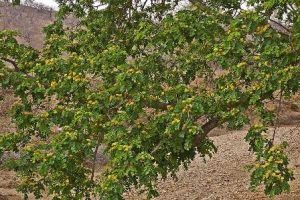
Albizia versicolor flowering. Photo: Meg Coates Palgrave. Source: Flora of Zimbabwe
As we moved up the slope other trees gave way to the Mfuti forest, amongst which we saw specimens of Stereospermum kunthianum (the Pink jacaranda). Although better known from lower altitudes, we do come across this species occasionally on rocky hills not far from Harare.
At the top, we rounded the bend in the fence to walk down and then up the other side of the valley. Vee spotted the shiny green leaves of Rhamnus prinoides (the aptly-named Shiny leaf) growing in the shade below us.
We came up with our friends waiting under a beautiful specimen of Albizia versicolor (the Poison-pod Albizia) then walked, with many distractions, down towards the buildings and our picnic lunches.
Many thanks, again, to the Vorsters for their hospitality.
-Ruth Evans
Visit to Jacana Yacht Club, Lake Chivero: 19 July 2009
Jacana Yacht Club is a relatively recently-discovered venue for the Tree Society. We visited it on 12 November 2006 and again on 15 July 2007, so this was our third visit.
Numbers were low on this outing (7) – perhaps the slightly greater distance daunted a few members? But in some ways fewer people mean slightly less pressure and we were able to spend more time discussing things of interest as we encountered them.
The actual vegetation is, not surprisingly, quite like that of the Lake Chivero Recreational Park, basically sandy woodland, at a slightly lower altitude than Harare, namely 1380 m. One feature is the magnificent and enormous termite mounds, supporting a rich dense vegetation of often quite large trees.
We started within the grounds of the Yacht Club and got our eyes in, as it were, with the species on the first termite mound. Amongst these were Mystroxylon aethiopicum (the Kooboo-berry). This is the species we used to call Cassine aethiopica. Like many Celastraceae, this has thickly-textured leaves which are shiny and finely toothed. The flowers are small and greenish-yellow and eventually small red berries are produced.
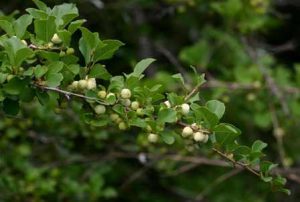
Flueggea virosa (the Snowberry tree. Photo: Bart Wursten. Source: Flora of Zimbabwe
Also present was Flueggea virosa (the Snowberry tree), Vitex payos, Euclea divinorum (very characteristic of termitaria), enormous Euphorbia ingens and Schotia brachypetala.
Two species were of particular interest. Capparis tomentosa (the Woolly caper-bush) is a tall woody climbing species with simple alternate leaves, bearing spines on the stems. Flowers at the appropriate season are large and striking with the numerous stamens typical of the family. The fruit are also large with pink flesh when ripe. This species sprawls over the vegetation on termite mounds and is quite common in and near the Yacht Club. Normally a species of low and medium altitudes, it achieves here a remarkably high altitude of 1380 m.
The other species of note was Boscia salicifolia, (the Willow-leaved shepherd’s tree) another member of the Capparaceae, which again like the Capparis prefers termite mounds, at least in the Chivero area. The specific name salicifolia means ‘with leaves like a Salix’. Some species of Salix are referred to in Europe as willows and it is these narrow-leaved species which are intended in this case.
We then walked out of the enclosed Club area and into similar woodland. It was obviously a rather dry and autumnal scene, but there was still quite a lot of interest.
One of the shrubs with black bacterial nodules in the leaves is Psychotria kirkii. Here it was common and at the fruiting stage; in all cases the fruiting stalk was hanging downwards. Whether this is a normal feature of this plant or not I don’t know, but it has since been recorded for posterity.
I should mention that we were very well served for photographers with no fewer than 5 of us bearing cameras, so every plant of interest received a lot of attention.
Meg Coates Palgrave pointed out an interesting feature of Burkea africana which was new to me. A specific lichen favours this species giving the whole trunk a pale greenish appearance. Once pointed out in the field, it was a very clear phenomenon, but looking at the photographs afterwards, the effect was much less obvious with the green colour appearing extremely pale.
One species in flower was the Winter-flowering Senna, Senna singueana. The flower is actually highly asymmetrical in structure. Specifically, it has a most unusual arrangement of the stamens; there are 10 in all; 3 large ones at one end; 4 medium-sized ones in the middle and three small ones at the other end. Details of the stamens are one of the reasons why the genus Senna is separated from the genus Cassia (apart from the easier character of the very elongated pods in Cassia).
Technically, Senna differs from Cassia in that:
• the stamens are basifixed (dorsifixed in Cassia);
• the filaments of the 3 longest are essentially straight (S-shaped and/or expanded in Cassia);
• dehiscence is by terminal pores only (both basal and terminal in Cassia).
A picture of the Senna flower in close-up will be placed on the Zimbabwe flora website in due course.
We then returned for a picnic lunch back at the Club.
In the afternoon I led the group down to the edge of Lake Chivero to look at the aquatic plants and to try and re-find a white-flowered aquatic that we had seen on one of our earlier visits. Aquatic plants are about as far off-topic for the Tree Society as you can get! However, this search produced a very rewarding outcome.
There was plenty of Eichhornia crassipes (Water hyacinth), which of course, Chivero is so famous for, lots of Myriophyllum aquaticum (Parrot’s feather) and one or two plants of Pistia stratiotes (the Water lettuce).
But also floating in the water was a species with broadly circular leaves, on the underside of which was a swollen air-filled mass. Some species of Lemna (duckweed) have a similar underside, but these leaves were 3-4 cm across and far too big for a duckweed. It was certainly not something I knew.
Photos were taken and I sent them to Bart Wursten, who identified it as the Amazon frogbit, Limnobium laevigatum from the family Hydrocharitaceae.
It may seem slightly strange that a species with Amazon in its name has found its way into Lake Chivero, but from the internet it seems to be commonly used in aquaria and possibly this is the way it has spread. It is a seriously invasive species in parts of California. According to the Flora of the Venezuelan Guayana, it grows at lake margins and in slow-moving rivers; it is scattered through northern Venezuela, Central Mexico, Central America, West Indies and S. America, except Chile.
This appears to be a new record for Zimbabwe and indeed southern Africa. It will be interesting to see how this species spreads in future.
˜
All in all, it was a very interesting day botanically with some excellent tree-ing in the morning and the find of an new aquatic plant in the afternoon.
We need to return again in November to try and catch the Limnobium in flower.
-Mark Hyde
Did you know?
Outdoor chefs appreciate the qualities imparted to meat on a braai by certain hardwoods. Oak, hickory and mesquite are often used in the northern hemisphere, while in our part of the world mopane, combretum and acacia species are popular. But one you should never use for cooking is tamboti, or Spirostachys africana. The copious latex sap [yes, it’s a Euphorbia!] is extremely toxic and burns with an odd, sweetish odour, at first aromatic and pleasant, but later becoming sickening and causing illness, while the smoke taints any food being cooked.
The wood of Spirostachys is close-grained, hard and very durable. Neither termites nor borers will touch it, and pieces of wood can be placed among clothing to serve as an insect repellent. The wood is so indestructible that well-preserved samples taken from great Zimbabwe for carbon dating were reported to be more than 1500 years old.
MATABELELAND CALENDAR
Please contact Jean Wiley or Gill Short for details of the next Matabeleland function.


